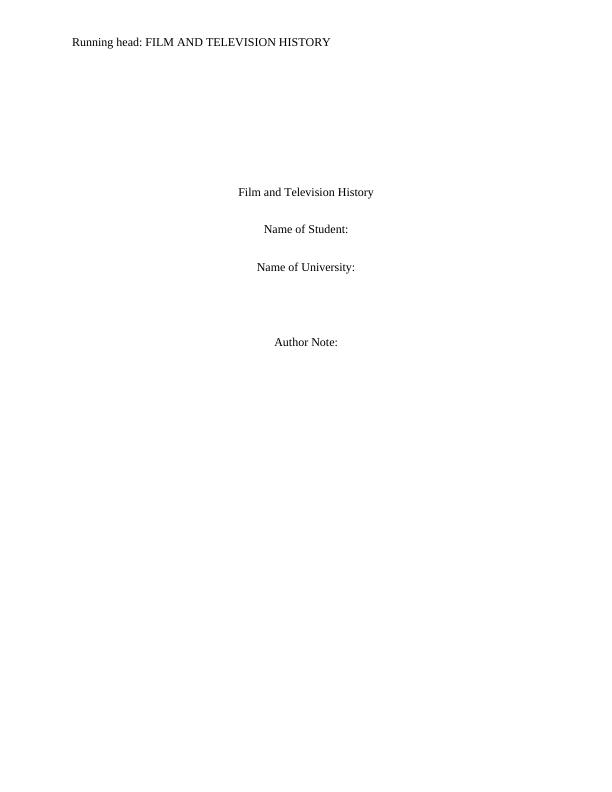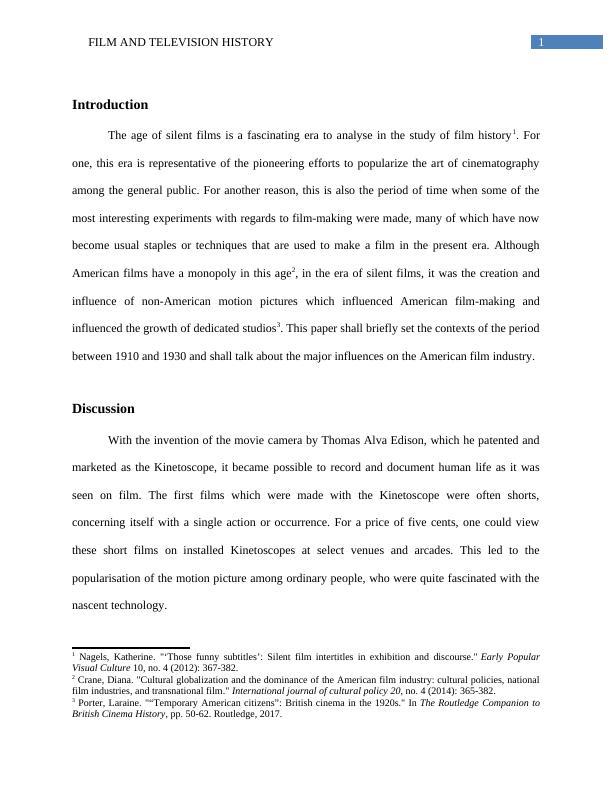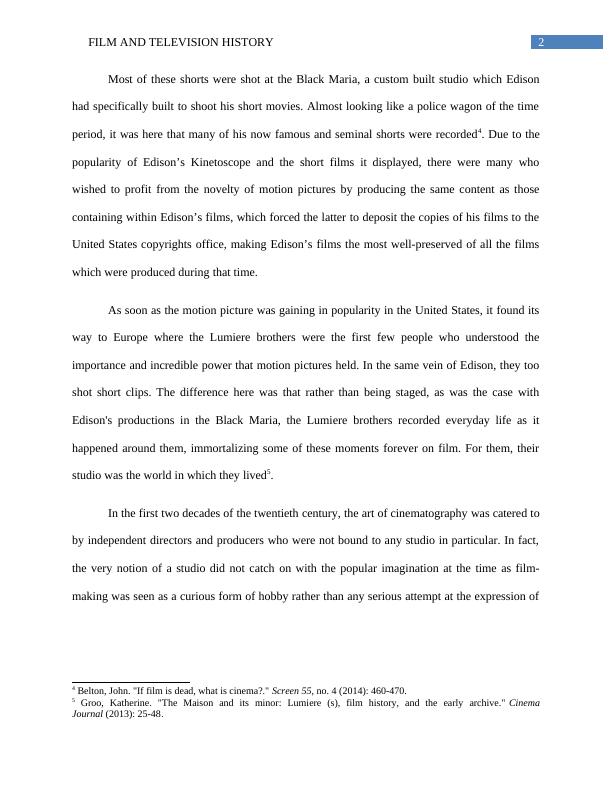Film and Television History
Added on 2022-11-30
9 Pages2272 Words52 Views
Running head: FILM AND TELEVISION HISTORY
Film and Television History
Name of Student:
Name of University:
Author Note:
Film and Television History
Name of Student:
Name of University:
Author Note:

1FILM AND TELEVISION HISTORY
Introduction
The age of silent films is a fascinating era to analyse in the study of film history1. For
one, this era is representative of the pioneering efforts to popularize the art of cinematography
among the general public. For another reason, this is also the period of time when some of the
most interesting experiments with regards to film-making were made, many of which have now
become usual staples or techniques that are used to make a film in the present era. Although
American films have a monopoly in this age2, in the era of silent films, it was the creation and
influence of non-American motion pictures which influenced American film-making and
influenced the growth of dedicated studios3. This paper shall briefly set the contexts of the period
between 1910 and 1930 and shall talk about the major influences on the American film industry.
Discussion
With the invention of the movie camera by Thomas Alva Edison, which he patented and
marketed as the Kinetoscope, it became possible to record and document human life as it was
seen on film. The first films which were made with the Kinetoscope were often shorts,
concerning itself with a single action or occurrence. For a price of five cents, one could view
these short films on installed Kinetoscopes at select venues and arcades. This led to the
popularisation of the motion picture among ordinary people, who were quite fascinated with the
nascent technology.
1 Nagels, Katherine. "‘Those funny subtitles’: Silent film intertitles in exhibition and discourse." Early Popular
Visual Culture 10, no. 4 (2012): 367-382.
2 Crane, Diana. "Cultural globalization and the dominance of the American film industry: cultural policies, national
film industries, and transnational film." International journal of cultural policy 20, no. 4 (2014): 365-382.
3 Porter, Laraine. "“Temporary American citizens”: British cinema in the 1920s." In The Routledge Companion to
British Cinema History, pp. 50-62. Routledge, 2017.
Introduction
The age of silent films is a fascinating era to analyse in the study of film history1. For
one, this era is representative of the pioneering efforts to popularize the art of cinematography
among the general public. For another reason, this is also the period of time when some of the
most interesting experiments with regards to film-making were made, many of which have now
become usual staples or techniques that are used to make a film in the present era. Although
American films have a monopoly in this age2, in the era of silent films, it was the creation and
influence of non-American motion pictures which influenced American film-making and
influenced the growth of dedicated studios3. This paper shall briefly set the contexts of the period
between 1910 and 1930 and shall talk about the major influences on the American film industry.
Discussion
With the invention of the movie camera by Thomas Alva Edison, which he patented and
marketed as the Kinetoscope, it became possible to record and document human life as it was
seen on film. The first films which were made with the Kinetoscope were often shorts,
concerning itself with a single action or occurrence. For a price of five cents, one could view
these short films on installed Kinetoscopes at select venues and arcades. This led to the
popularisation of the motion picture among ordinary people, who were quite fascinated with the
nascent technology.
1 Nagels, Katherine. "‘Those funny subtitles’: Silent film intertitles in exhibition and discourse." Early Popular
Visual Culture 10, no. 4 (2012): 367-382.
2 Crane, Diana. "Cultural globalization and the dominance of the American film industry: cultural policies, national
film industries, and transnational film." International journal of cultural policy 20, no. 4 (2014): 365-382.
3 Porter, Laraine. "“Temporary American citizens”: British cinema in the 1920s." In The Routledge Companion to
British Cinema History, pp. 50-62. Routledge, 2017.

2FILM AND TELEVISION HISTORY
Most of these shorts were shot at the Black Maria, a custom built studio which Edison
had specifically built to shoot his short movies. Almost looking like a police wagon of the time
period, it was here that many of his now famous and seminal shorts were recorded4. Due to the
popularity of Edison’s Kinetoscope and the short films it displayed, there were many who
wished to profit from the novelty of motion pictures by producing the same content as those
containing within Edison’s films, which forced the latter to deposit the copies of his films to the
United States copyrights office, making Edison’s films the most well-preserved of all the films
which were produced during that time.
As soon as the motion picture was gaining in popularity in the United States, it found its
way to Europe where the Lumiere brothers were the first few people who understood the
importance and incredible power that motion pictures held. In the same vein of Edison, they too
shot short clips. The difference here was that rather than being staged, as was the case with
Edison's productions in the Black Maria, the Lumiere brothers recorded everyday life as it
happened around them, immortalizing some of these moments forever on film. For them, their
studio was the world in which they lived5.
In the first two decades of the twentieth century, the art of cinematography was catered to
by independent directors and producers who were not bound to any studio in particular. In fact,
the very notion of a studio did not catch on with the popular imagination at the time as film-
making was seen as a curious form of hobby rather than any serious attempt at the expression of
4 Belton, John. "If film is dead, what is cinema?." Screen 55, no. 4 (2014): 460-470.
5 Groo, Katherine. "The Maison and its minor: Lumiere (s), film history, and the early archive." Cinema
Journal (2013): 25-48.
Most of these shorts were shot at the Black Maria, a custom built studio which Edison
had specifically built to shoot his short movies. Almost looking like a police wagon of the time
period, it was here that many of his now famous and seminal shorts were recorded4. Due to the
popularity of Edison’s Kinetoscope and the short films it displayed, there were many who
wished to profit from the novelty of motion pictures by producing the same content as those
containing within Edison’s films, which forced the latter to deposit the copies of his films to the
United States copyrights office, making Edison’s films the most well-preserved of all the films
which were produced during that time.
As soon as the motion picture was gaining in popularity in the United States, it found its
way to Europe where the Lumiere brothers were the first few people who understood the
importance and incredible power that motion pictures held. In the same vein of Edison, they too
shot short clips. The difference here was that rather than being staged, as was the case with
Edison's productions in the Black Maria, the Lumiere brothers recorded everyday life as it
happened around them, immortalizing some of these moments forever on film. For them, their
studio was the world in which they lived5.
In the first two decades of the twentieth century, the art of cinematography was catered to
by independent directors and producers who were not bound to any studio in particular. In fact,
the very notion of a studio did not catch on with the popular imagination at the time as film-
making was seen as a curious form of hobby rather than any serious attempt at the expression of
4 Belton, John. "If film is dead, what is cinema?." Screen 55, no. 4 (2014): 460-470.
5 Groo, Katherine. "The Maison and its minor: Lumiere (s), film history, and the early archive." Cinema
Journal (2013): 25-48.

End of preview
Want to access all the pages? Upload your documents or become a member.
Related Documents
American Film Industrylg...
|6
|1409
|338
Charlie Chaplin and the History of Silent Filmslg...
|4
|996
|453
(PDF) Cinematography and filmmaking researchlg...
|8
|2130
|84
Comedy in Film Industry Essaylg...
|9
|2714
|74
Alfred Hitchcock | Biographylg...
|4
|826
|12
Film Review Techniques And Assesment Reportlg...
|7
|1677
|19
